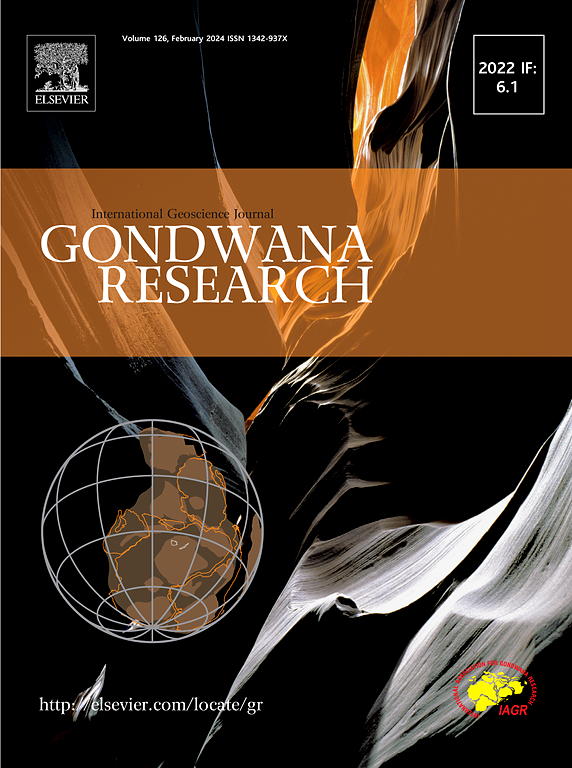协同作用与斗争:南亚实现可持续发展目标6和13中的水安全和气候行动
IF 7.2
1区 地球科学
Q1 GEOSCIENCES, MULTIDISCIPLINARY
引用次数: 0
摘要
南亚拥有全球近四分之一的人口,在实现可持续发展目标(SDG)方面面临重大挑战,特别是可持续发展目标6(清洁水和卫生设施)和可持续发展目标13(气候行动)。本综述通过文献计量分析、政策报告和案例研究相结合的方法,分析了该地区在解决水资源短缺、卫生设施不足和气候脆弱性方面取得的进展。文献计量学分析的重点是2016年至2024年的文献,从Scopus数据库中选择与可持续发展目标6和可持续发展目标13相关的关键词。使用了Biblioshiny、VOS viewer和Excel等工具来可视化研究领域的趋势、协作模式和差距。分析显示,对南亚水和气候问题的研究越来越多(2016年至2024年期间,关于可持续发展目标 6和 13的研究出版物增加了55% %)。关键词共现卡方检验突出了围绕“水资源管理”和“气候适应能力”的重要专题集群,线性回归显示可持续发展目标出版物的平均年增长率为8.2% %。此外,尽管南亚地区的跨境合作正在改善,但在气候数据监测和水资源综合管理(IWRM)实施等领域仍存在重大差距,阻碍了有效的政策制定和可持续发展目标具体目标的进展跟踪。供水和卫生设施仍然是整个区域面临的主要挑战。尽管研究工作有所加强,但获得水的机会仍然不均衡:92% %的南亚城市居民获得了安全管理的饮用水,而农村居民的这一比例为64% %,只有58% %的农村家庭改善了卫生设施。南亚地区的跨境合作增长了32% %,但在水资源综合管理和实时气候监测方面仍然存在差距。极端天气事件,洪水每年使500多万人流离失所,干旱影响12. %的农田——进一步使基础设施紧张。我们建议对气候适应型水和卫生系统进行有针对性的投资,采用综合水资源管理战略,建立区域数据共享平台,以支持基于证据的政策,推动实现2030年可持续发展目标的具体目标。本文章由计算机程序翻译,如有差异,请以英文原文为准。

Synergies and struggles: Water security and climate action in South Asia’s quest for SDG 6 and SDG 13
South Asia, home to nearly a quarter of the global population, faces significant challenges in achieving the Sustainable Development Goals (SDGs), particularly SDG 6 (Clean Water and Sanitation) and SDG 13 (Climate Action). This review paper analyzes the region’s progress in addressing water scarcity, inadequate sanitation, and climate vulnerabilities through a combination of bibliometric analysis, policy reports, and case studies. The bibliometric analysis focuses on literature from 2016 to 2024, selected from the Scopus database using keywords related to SDG 6 and SDG 13. Tools such as Biblioshiny, VOS viewer, and Excel were employed to visualize trends, collaboration patterns, and gaps in the research landscape. The analysis reveals an increasing volume of research on water and climate issues in South Asia (55 % increase in research publications on SDG 6 and SDG 13 between 2016 and 2024). Keyword co‑occurrence chi‑square tests highlighted significant thematic clusters around “water management” and “climate resilience,” and linear regression revealed an average annual growth rate of 8.2 % in SDG publications. Moreover, while cross-border collaboration within South Asia is improving, significant gaps remain in areas such as climate data monitoring and the implementation of integrated water resource management (IWRM), hindering effective policy formulation and progress tracking toward SDG targets. Water access and sanitation continue to represent major challenges throughout the region. Despite the increase in research, water access remains uneven: 92 % of urban South Asians have safely managed drinking water compared to 64 % of rural residents, and only 58 % of rural households have improved sanitation. Cross‑border collaboration within South Asia grew by 32 %, yet gaps persist in integrated water resource management (IWRM) and real‑time climate monitoring. Extreme weather events, floods displacing over 5 million people annually, and droughts affecting 12 % of cropland, further strain infrastructure. We recommend targeted investments in climate‑resilient water and sanitation systems, adoption of IWRM strategies, and a regional data‑sharing platform to support evidence‑based policy and advance progress toward the 2030 SDG targets.
求助全文
通过发布文献求助,成功后即可免费获取论文全文。
去求助
来源期刊

Gondwana Research
地学-地球科学综合
CiteScore
12.90
自引率
6.60%
发文量
298
审稿时长
65 days
期刊介绍:
Gondwana Research (GR) is an International Journal aimed to promote high quality research publications on all topics related to solid Earth, particularly with reference to the origin and evolution of continents, continental assemblies and their resources. GR is an "all earth science" journal with no restrictions on geological time, terrane or theme and covers a wide spectrum of topics in geosciences such as geology, geomorphology, palaeontology, structure, petrology, geochemistry, stable isotopes, geochronology, economic geology, exploration geology, engineering geology, geophysics, and environmental geology among other themes, and provides an appropriate forum to integrate studies from different disciplines and different terrains. In addition to regular articles and thematic issues, the journal invites high profile state-of-the-art reviews on thrust area topics for its column, ''GR FOCUS''. Focus articles include short biographies and photographs of the authors. Short articles (within ten printed pages) for rapid publication reporting important discoveries or innovative models of global interest will be considered under the category ''GR LETTERS''.
 求助内容:
求助内容: 应助结果提醒方式:
应助结果提醒方式:


